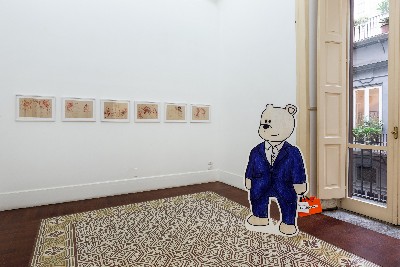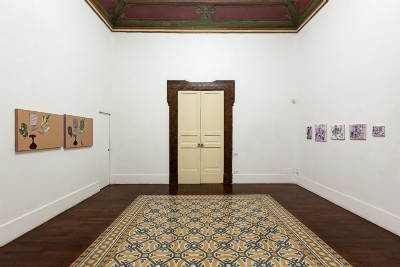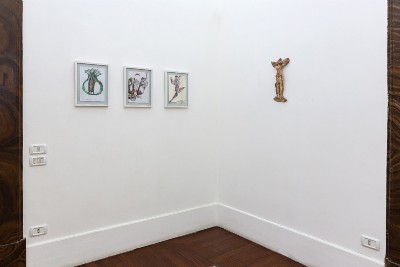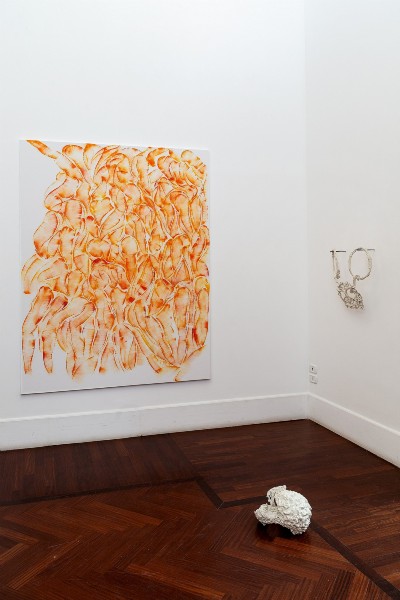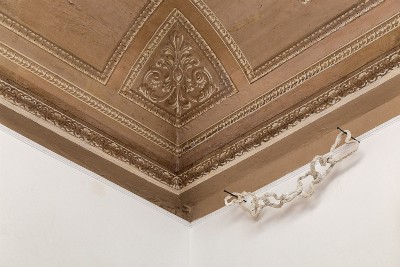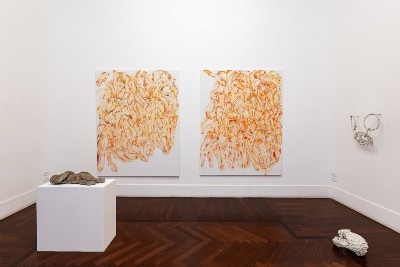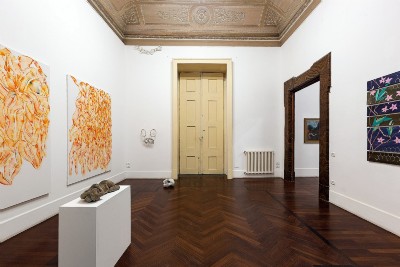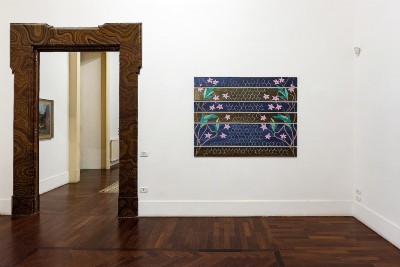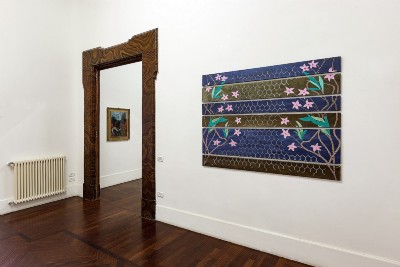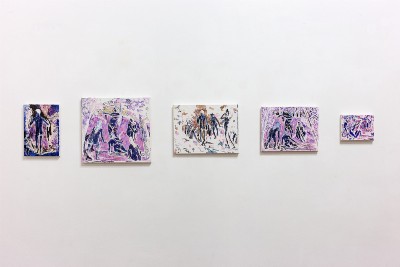PARABASIS is an exhibition project born from a series of conversations about the possibility of formulating new formal strategies on the representation of the work of art. The original stimulus arose from parallelisms that emerged between investigative practices belonging to past and present artistic production. More precisely, we looked at a certain European production, mostly Southern, carried out under the fascist regime and in the years immediately following. We observed a series of analogical correspondences with a certain non-aligned, contemporary production that demonstrates a similarly anarchoid, if not anti-academic attitude, while also maintaining rigorous, compositional methods. Ultimately, extensive iconographic research and pervasive conversation shared with the various artists and with Di Caro, led to a showcase of highly significant, yet rarely seen work from artists of emergent, mid-career, as well as historical positions.
The artworks taken into examination, stemming from international experiences and being often inspired by specific cultural references, each tend to radicalize the weakness of quotation as a consolidated, conceptual source. Furthermore, if observed from an angle that considers the daily relationship with things, the meaning of colors and form in the evocation of a memory, all the works involved can be seen as allegorical transits into human existence, or rather, as a variation to the peremptory nature of the real. Maybe it is a coincidence, but the revaluation of formal values over content (and the understanding of styles as forms of vision and representation) was theorized at the end of the nineteenth century by von Mar??es and his two friends 1 right here in Naples. It is therefore extremely fascinating to note that, in 2020, objective research on the behavior of forms is also entertained by artists who operate from expressionist and surrealist positions (and not strictly formalist or conceptual.) In his essay On evaluation (1876), Fiedler puts it clearly: "What art creates is not a second world alongside another that would exist anyway without it, but through artistic consciousness, art produces the world for the first time".
Eight excursus were then diachronically adjoined and unleashed. The respective interventions offered themselves instrumentally, for the constitution of a moment: an intermezzo that is close to a parabasis - a term that literally means the act of walking sideways, deviating, transgressing. Parabasis is the comedic brake established by the choir when it takes off its mask and turns directly to the spectators, returning to its original role of komos - a cheerful, insolent Dionysian cortege. Parabasis as "the interruption in which suddenly the origin appears, breaking and disrupting the expected development of the action." 2
As Pasolini used to say, art is a force of the past - still a spiritual fact. When we are invested by it, we realize that it always contains elements of past reflections that transform us. Precisely, by emphasizing its non-contemporaneity, art can accentuate its own note out of tune in the choir. Only then can a truly modern dialogue with the present be initiated.
The mediocrity of our universes essentially depends on our powers of enunciation. How can we recover this power today? A managerial/synthetic language is being substituted for the language of our inner character. Contemporary language has been "turned", in the way the police use this term, since it aims at disinforming us about ourselves, by mis-teaching us to feel better about unlearning our ability to discern. It is particularly the psychological utilization of terms such as "motivation", "to manage", "to valorize" and even "to negotiate" that leads to the devaluation of any sensible approach to the self.
Language, though damaged, remains a weapon that anyone can reclaim, here and now. Through it, it is possible to retake from this world a part of it that is being taken away from us day by day. A bit like the anarchists at the beginning of the 20th century who engaged in individual reprisals, seizing every occasion to retake from society a part of what it had taken from them. Because language is a strange treasure that doesn't belong to anyone in particular, but everyone can enrich it and be enriched by it.
2019, Francesca Lacatena
1 The relationship between Hans von Mar??es, theorist Konrad Fiedler and the sculptor A. von Hildebrand had considerable importance for the formulation of the so called theory of "pure visibility" (reine Sichtbarkeit). In 1873, von Mar??es was commissioned to paint what is considered his masterpiece, the cycle of frescoes that decorates the library of the Anton Dohrn Zoological Station, in Naples.
2 Giorgio Agamben, Pulcinella or Entertainment for children, Seagull Books, 2019.
Participating Artists
Betty Bee's (*1962, Naples) practice borders with body art, pop figuration and performance. Her work is recently having a strong ascendant on artists from younger generations. We can say, though, that an indirect influence exerted by the singular ethic and aesthetic stance of Betty Bee, can clearly be detected all the way back in the early 1990s. If we look at the topical-visual curriculum of some amongst the Young British Artists, who in those viscous and promiscuous years assiduously frequented Naples and the court of Umberto Raucci and Carlo Santamaria, it turns out, for example, that Gilda, 1994 (video, 4m) , or the comics-on-canvas Betty Bee - how to become crazy (artist), 1992, are antecedent to some very notorious piece by Tracey Emin (The tent was first exhibited by Carl Freedman in April 1995, in the group show Minky Manky at the South London Gallery.) Fact is, in Betty Bee's project the po(i)etic and therapeutic strategies that are present, have always pushed self-quotation beyond the regulatory domain of the narcissistic condition. In order to break down and exorcise her self-referential affliction, Betty Bee continues to work not only within, but also outside a highly controversial, identity space, exploiting all dilemmas which derive from it - some of it is truth, some of it is mask and disguise. Between an affront and a drafting of similarly premeditated acrylic gloss, with her industriousness, Betty Bee exposes herself to a grafting practice from which an unmistakable visual landscape originates. The three recent paintings chosen for the exhibition, Untitled I and II (diptych), 2017, and the "broken" canvas Untitled, 2015, exhibited here for the very first time, offer pictorial glimpses of irrefutable and delicate compositional rigor. The protective net that characterizes Betty Bee's imagery, in none of the three cases covers the canvas completely, but only a part of it: with a rather large weave, it prevents us from accessing the comforting passage that is set before us.
Guido Casciaro's (Naples, 1900 - 1963) painting investigated above all the macrocosm of Campania, interpreting it with the same difficulties as the other Neapolitan painters, who had to reconcile their artistic ideas with the heavy climate, following the Press Law from 1924. The National Fascist Party, immediately after that date, became increasingly oppressive also in the field of the Arts, trying to impose from above a language common to all Italian artists. After the 1930s, Casciaro created a solid and synthetic painting, working on bruised, earthy and sometimes anti-poetic urban landscapes. With quick strokes, he investigated the less oleographic aspects of his city adopting unconventional compositions and subjects, dense mixtures, and unexpected color combinations. He chose un-picturesque subjects, such as urban scenes with degraded buildings, streets under construction, new construction sites of Castellammare and the shacks of the most derelict. His palette was nourished by the pictorial sap of a realism dear to Michele Cammarano, and by the very bright flair of Antonio Mancini, from whom he assimilated a materic way of painting, often rich in unpredictable results. In Casciaro, we find seventeenth-century vibes laden with a modern feeling of color, and enclosed in a rather unorthodox, scenic frame. His naturalism is vibrant and deprived of any traditional charm. Precisely for these characteristics, the works of Guido Casciaro represent some of the most valid and rare testimonies on the orientations of Neapolitan painting at the turn of the 1940s and 1950s. Fontelina, 1947, a small oil on plywood, is the first of a series of paintings he made during a summer in Capri, after the war.
Effe Minelli's (*1988, Naples) work explores processes of survival and evolution that allow an escape point from pre-configured expressive modalities. In his work, everything originates from the body, in its most fragile, repressed form, sometimes sick and difficult to heal. In this state of physical despair, Minelli preserves his freedom to experiment with different media, going from writing to music, and from drawing to sculpture. Performance allows the entertainment of a forbidden contact with the sculptures. The installation entitled Study for a Salome' in the square, 2020, specifically conceived for Di Caro's gallery space, is composted of porcelain paraphernalia already used during the performance Balcony, 2017, held at the HFBK, in Hamburg. Integral to the volumetric composition and linked to Minelli's scenic kit is the seminal sculpture, Head, 2017, also made in Limoges porcelain, originally molded in freehand while looking at the Farnese Hercules. Later, as Minelli tells us, an addition of hair, rags and rope to the negative mold was made, and the fair pride of the Hercules went vanishing away: the white porcelain head extracted from the same mold looked now more like that of a tormented John the Baptist, victim of a Salome' dressed up in seductive laces. The original cast, now lost, has been used three times until its decay, producing three, unique pieces.
Timothy Davies's (*1983, London) conceptual research operates through intertextual relationships, combining unprecedented conjugations between found or slightly modified objects, different motifs and images. His practice seems to indicate new possible contingencies of what appears to be "given." His plywood teddy bears refer to the personal branding and relational strategy of performing cuteness, self-infantilization, and vulnerability. In an introductory text written on the occasion of his solo Forever Teddy Complex, a show conceived for Sandy Brown in March 2019, Davies explains "the 'Teddy Bear Complex', or, more simply 'Teddy Complex', describes the tendency to present the self as a surprise gift to the world. Grown-ups dressed like teddy bears can be seen as symptomatic of the Teddy Complex, exhibiting a resistance to 'adulting' (and a logical next step on from the shutting-out-the-world statement of last season's signature duvet coat). The Teddy Complex is expressed through conspicuous displays of emotive objects and styling (on the person and via interior design choices), which are intended to signal vulnerability, availability, or cuteness-attributes which might contradict the actual, day-to-day activities and behaviours of the so-called 'teddy'. The physical manifestations of a Teddy Complex do not need to involve teddy-themed apparel but must appeal to a third party in the same way that a teddy bear places its demands for affection. No more or less sincere because of its state of acute self-awareness, the modern teddy finds comfort in its fabric skin and simplified, representational form."
Rosa Panaro's (* 1934, Casal di Principe) work from the late 70s, although devoted to specific research on materials, such as papier-m??ch?? and clay, is still in balance between a lyric gesturality and an investigation into the evocative potential of matter. Her experience with Informalism returns in a fantastic key in the sculptural works of those years, giving rise to a hazardous - and yet quite profound - study on vernacular archetypes in their utmost organic matrices. The same archetypes that Panaro will continue to investigate over the following decades, till we find them in an updated context. For the exhibition, three recent drawings in A4 format were chosen, as to carry out a current compendium of subjects modeled by Panaro along the past four decades: the Liliths, the Pomegranate, the Crowd. Panaro revives these symbols by drawing and by using the collage technique. She recontextualizes her cosmogony through a "graphic sculpture" already theorized by Enrico Crispolti in the late 1970s (when some of her Kernels reappeared as drawings in black markers on golden cardboard). On display, therefore, we will find a Panaro 2.0 (2020!) a slightly Dadaist Panaro, delighted to re-work her classic subjects. The technique that seems to be her favorite, which best renders the always sought-after three-dimensionality, consists on drawing with water-based markers on photocopied sheets. In fact, the series of works we propose in the exhibition, is entirely made drawings which were "redesigned" on xerox supports. We are convinced that these new compositions expose Panaro's often ironic and mischievous imagination, while also carrying out her infinitely complex, existential phantasmagoria. These works invite us to discover the current life of the Spouses of priests, who, as we happen to find out, in 2020 become a Trinity; we meet again a Lilith, but today, on paper, she is entitled Pieta'. Panaro, without any intellectualistic pretension, has understood that everything we call myth is conditioned and mediated by language: precisely in the sense that it is connected to an original deficiency of the language, its innate inability. Each linguistic designation is necessarily poly-sense; and in this plurality of meanings, the source and origin of all myths is to be found.
Matthias Schaufler (*1964, Laichingen) also inherits the characteristic openness and extreme availability of Informalism. His innovative approach to conceptualism lends his research to a methodic subversion of line as contour. The stroke of the line having no longer the function of blocking out the background, but rather of making the background accede to the status of figure - while the figures, in the traditional sense of the term, appear as simple accidents of reading in the continuity of a text that obeys another, more subtle cutting-out than the one given us by the grid of language. The three paintings included in the exhibition are part of a new corpus following the methodological exhaustion of the previously adopted techniques. It could be said that, the large canvas entitled Gray, 2019, was born from a rediscovered formal harmony which was triggered by a series of drawings produced during one of the artist's stay in Ireland. For this reason, the six abstract watercolors Ohne Titel, 2019, have been also included to the exhibition, as a sort of evolutionary testimony, to lead the visitor by the hand through the compositional course of one of the most interesting exponents of contemporary abstractionism. Orange Night in Naples I and II, are the very first, powerful canvases to emerge as not yet conclusive - and therefore pursuable - from Schaufler's - artist of the open form and relative clarity - newly found, painting style.
Megan Francis Sullivan's (* 1975, Stamford) practice draws out artefacts of various kinds and affiliations to various cultural traces, via the creation or interpretation of works and objects from specific sources. Her research questions the historical base plate of the artistic work as site and time-specific. The painting series that inverts Paul Cezanne's The Bathers, is an on-going project, paradigmatic of how the artist recasts authorship and desires in associative entanglements. The inversions we are delighted to present within the Neapolitan exhibition have been all completed in January 2020. They are therefore only the liminal pieces of a project that began in 2016, as an engagement in radicalizing the weakness of stylistic quotation, while implementing a total, crystalline appropriation of Cezanne's compositional and obsessive moment. In each, tiny d??tournement Sullivan expresses the identification of her painting technique in the structural approach the Provencal painter pursued from the seventies of the nineteenth century, until the end of his life. Her greatest ambition is to achieve a complete fusion of the human figure and the landscape. Yet, she is also seeking an involvement in a discourse that marks the gap between matter of choice and originality, acquisition and process, past and current implications related to trends etc. Retracing the emotional, structural and volumetric specificity of each composition found on the internet, Sullivan is possessed by Cezanne's conic, formalist dream. The series of The Bathers (Inverted) advances, as she repaints the voluptuous diagonals of her solarized negatives, canvas by canvas.
Antonietta Raphael's (Kaunas, 1895 - Rome, 1975) choice to mainly work with sculpture, takes place in 1930, during her stay in Paris with Mario Mafai. She is almost forty years old and has just started to emerge as a painter in Rome, when she decides to leave. Sculpture becomes the medium of choice, the one in which she pours her visceral anxiety, as well as the millennial suffering of the Jewish people. In Raphael's plastic project from the 1930s, a stylistic trait of unexpected and surprising serenity develops, along with an attention to grasp the more strictly formal implications of her work. While admiring Marino Marini, Raphael removes herself from the formalist sublimity of the classicist world. Her production rejects any form of metaphysical frostiness, just as she refuses to become the priestess of a cult that, in fact, disengages Italian art in a perennial ancestral appeal. Hermaphrodite, 1937, a small sculpture from the Genoese period damaged by bombing, coincides with an entirely new way of looking at the behavior of form. From then on, Raphael will start to bend the poetics of the fragment to her purposes: using its formal modality, drawing incisive, operational suggestions from it. The small concrete sculpture from '37 anticipates the mutilations carried out in 1948 - following the exhibition of the Three sisters, 1941-1948, at the Venice Biennial - and pursued up to the bronze castings of the '60s. The one carried by Raphael is, therefore, not a research on fragmentism, but sheer fragmentation: qualitative decomposition of the vision in a profoundly anti-academic function, and moral revolt from the subdued walls of domestic territory.
